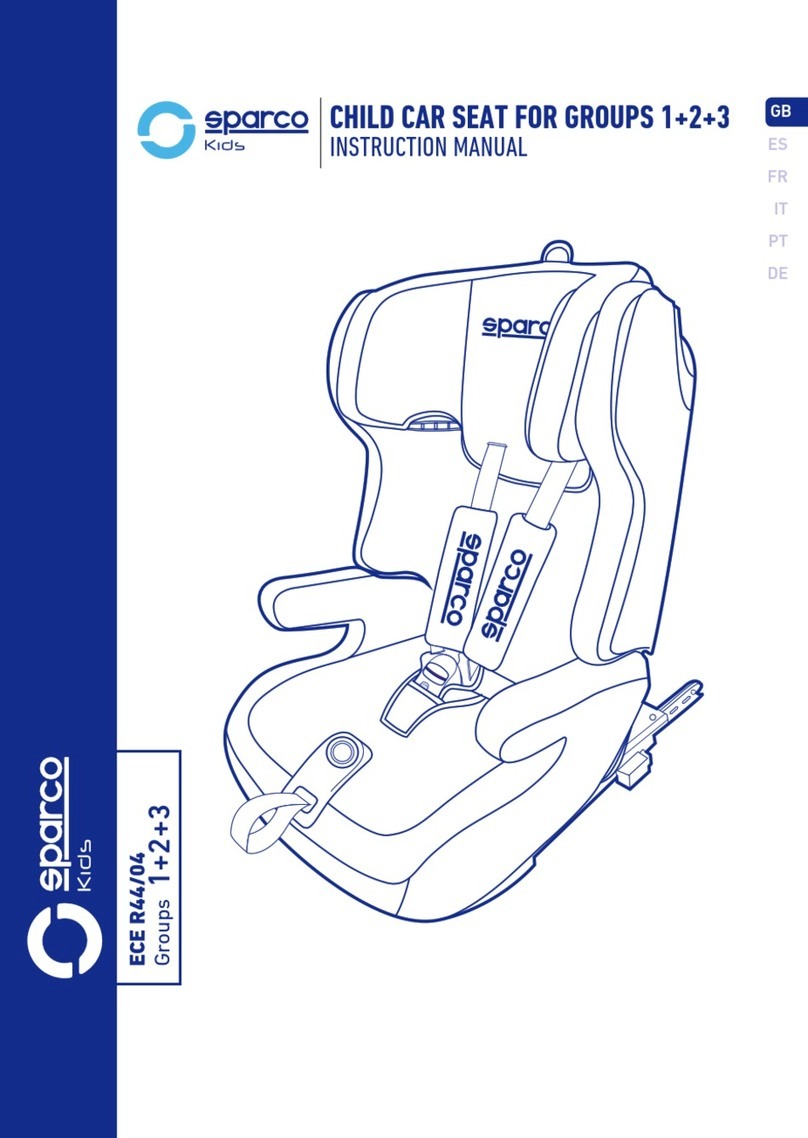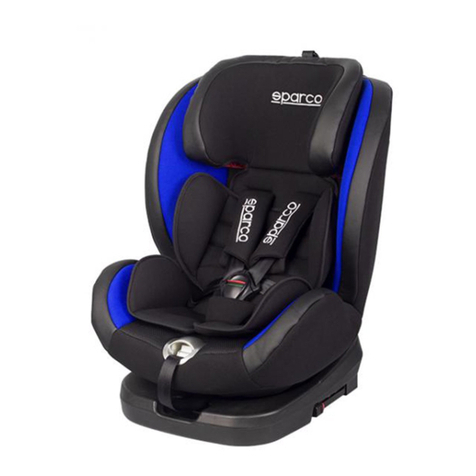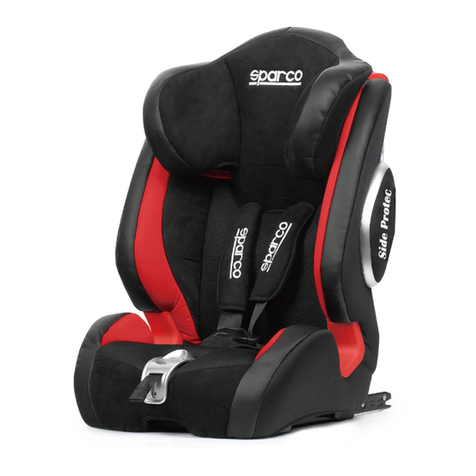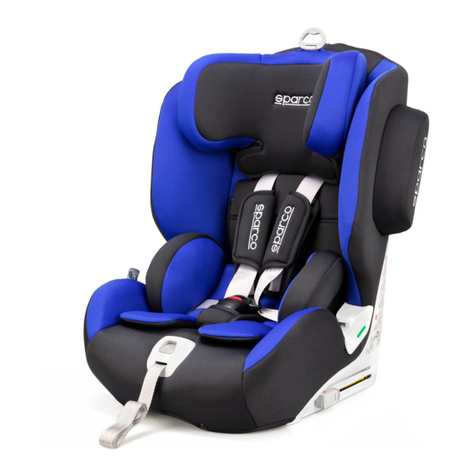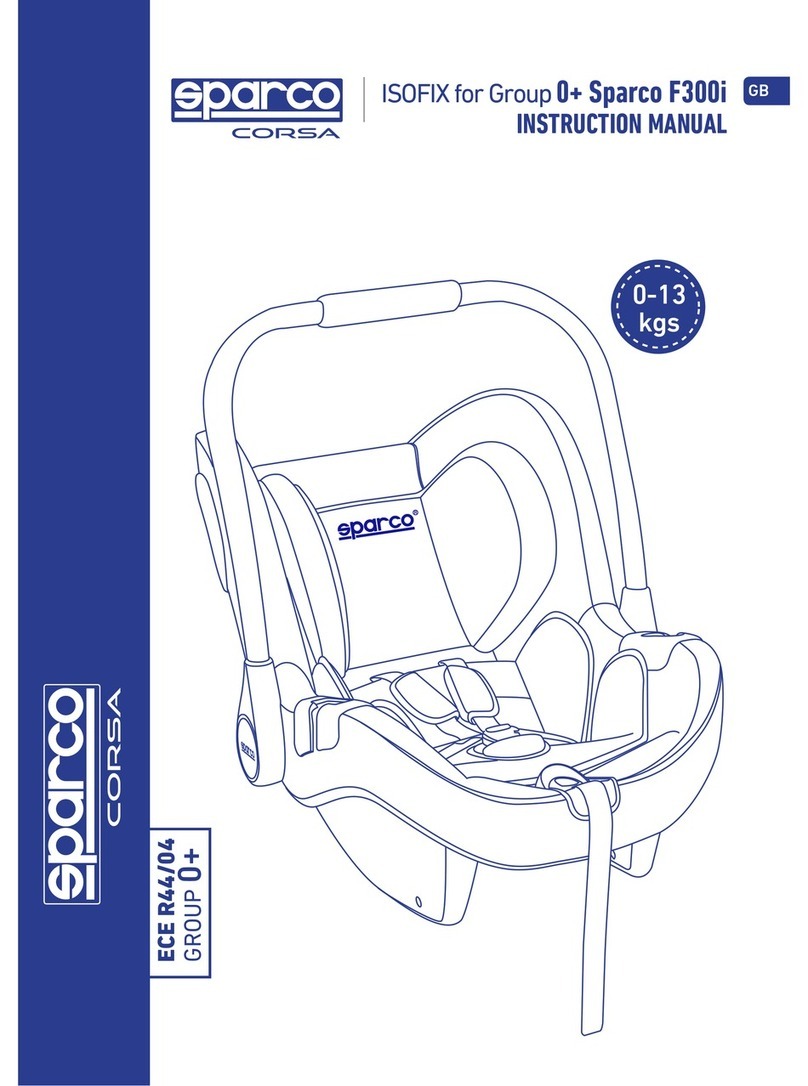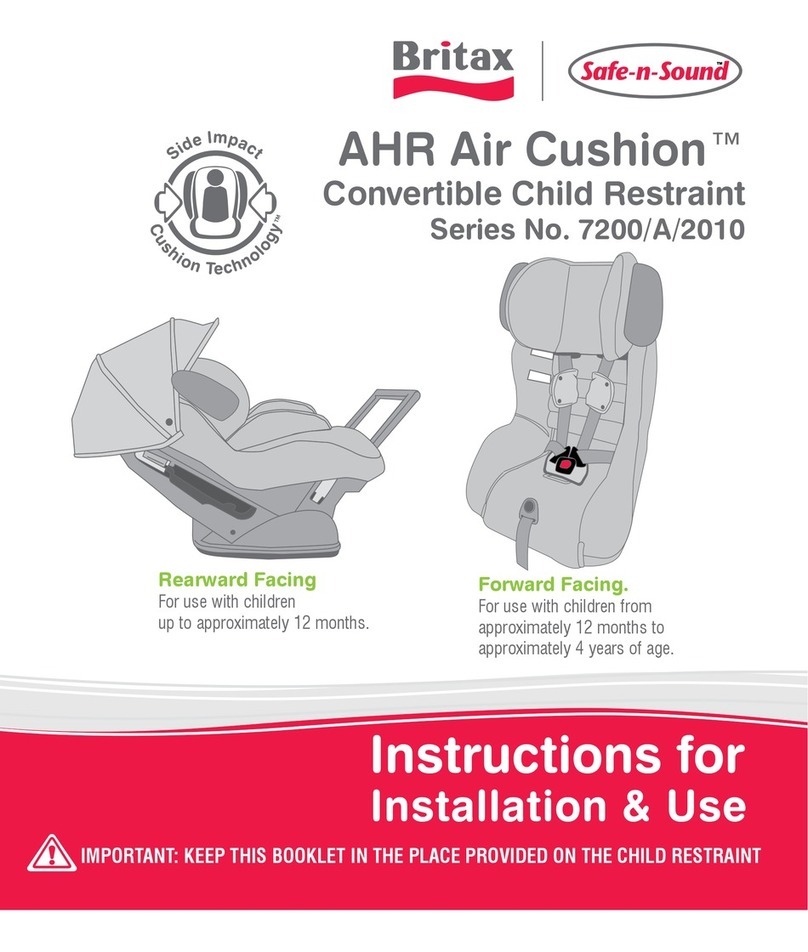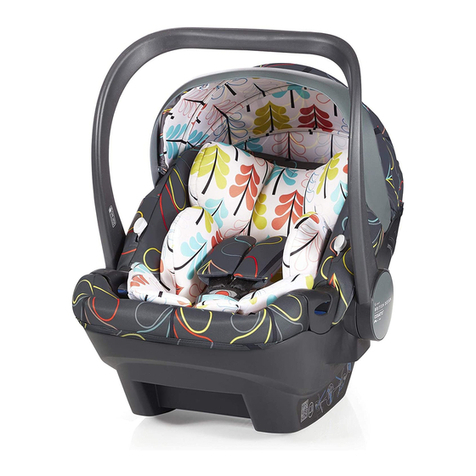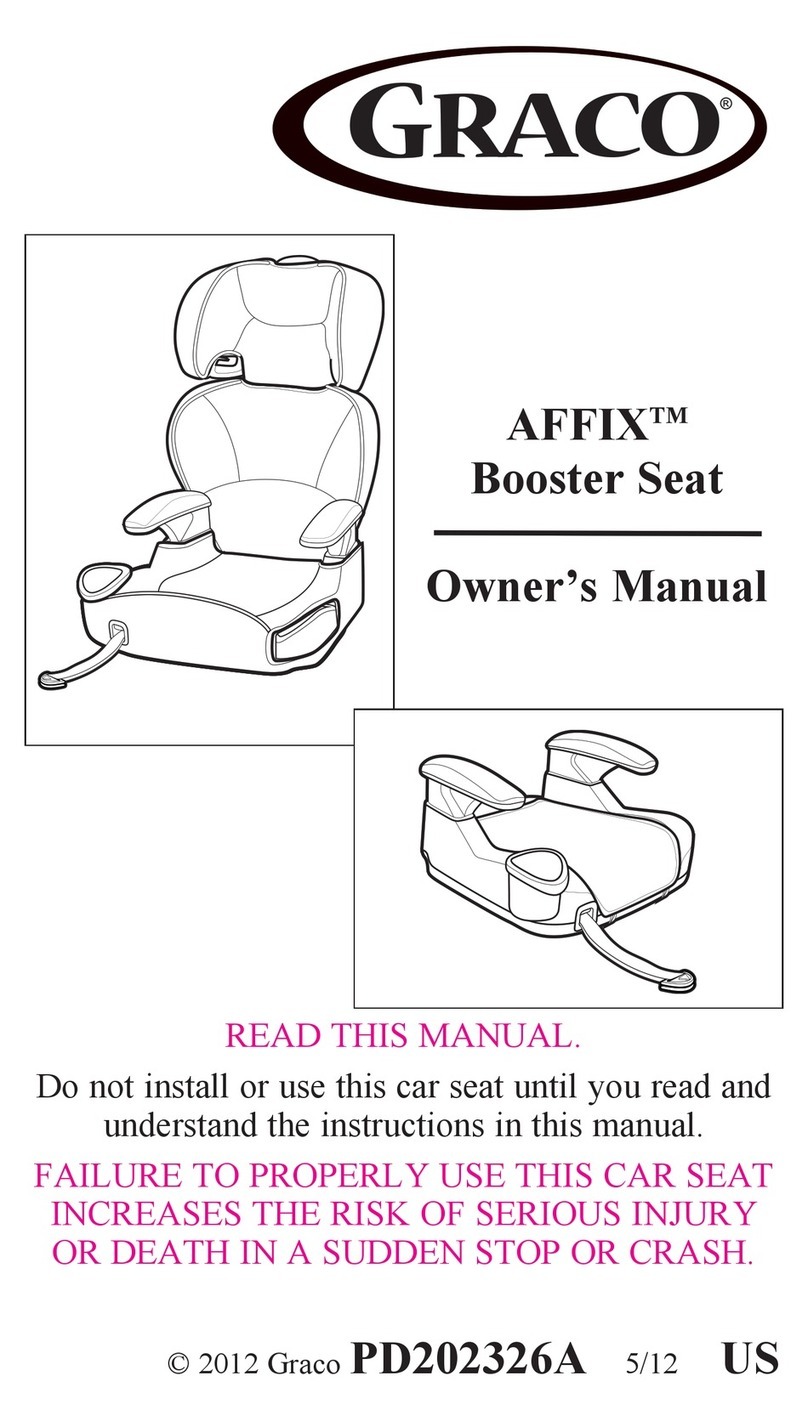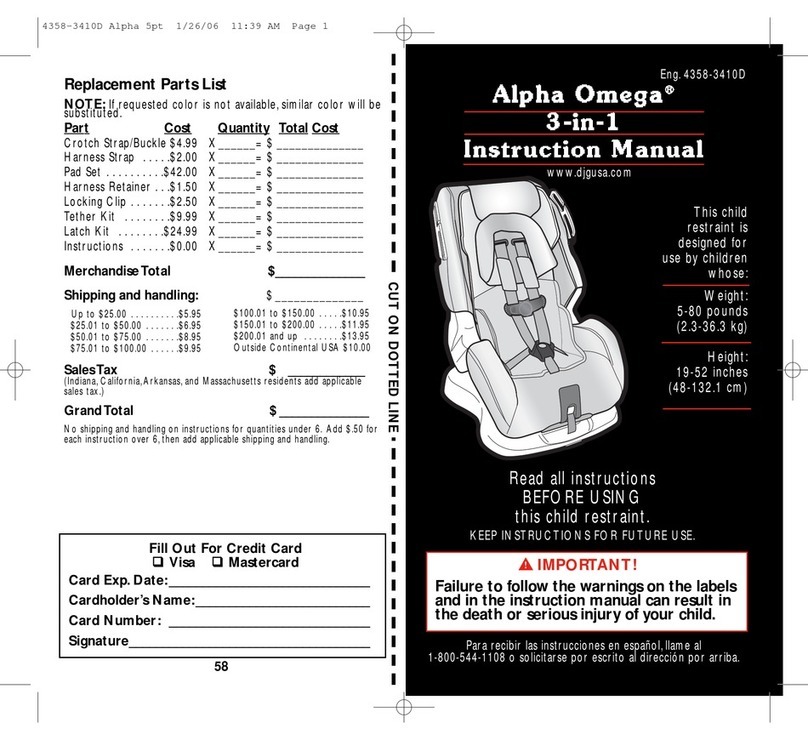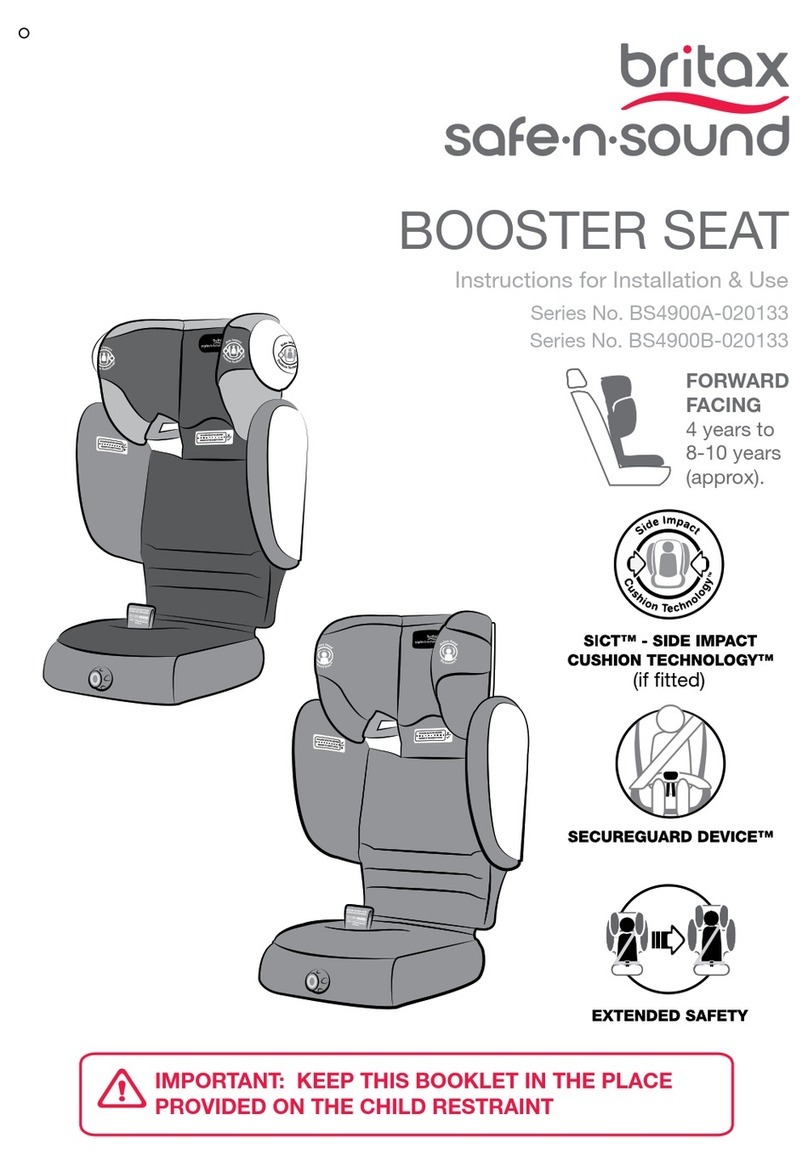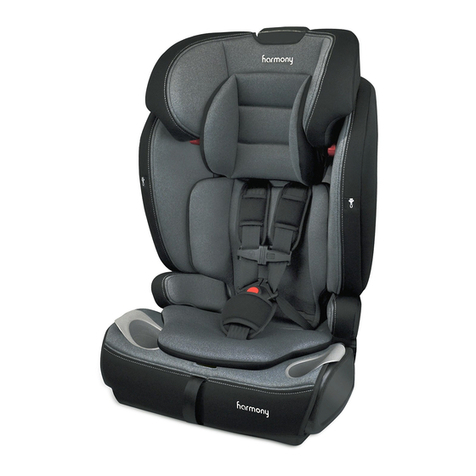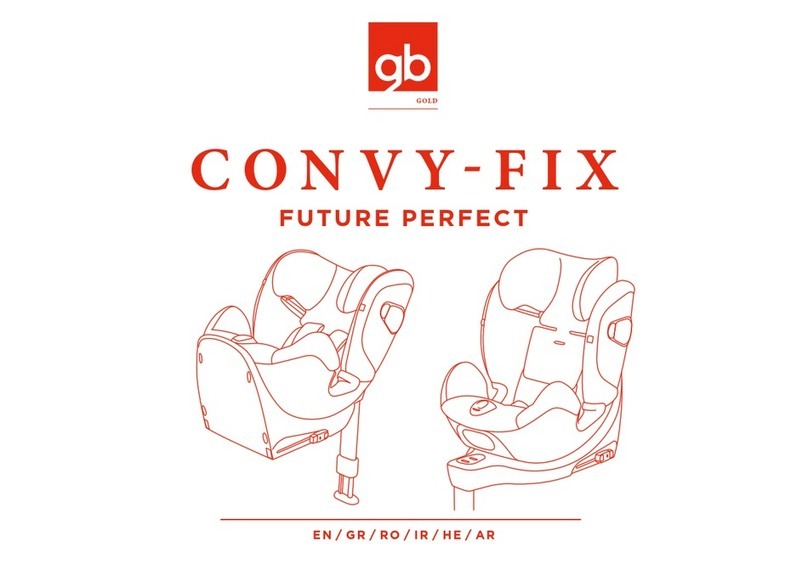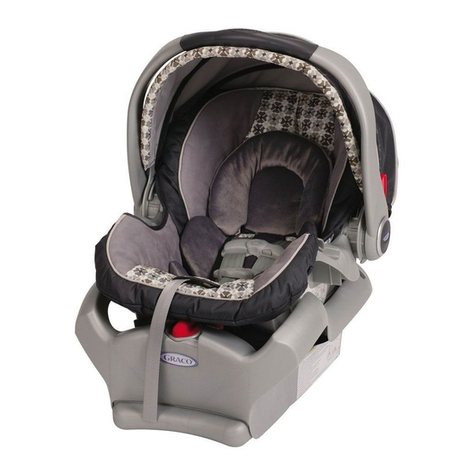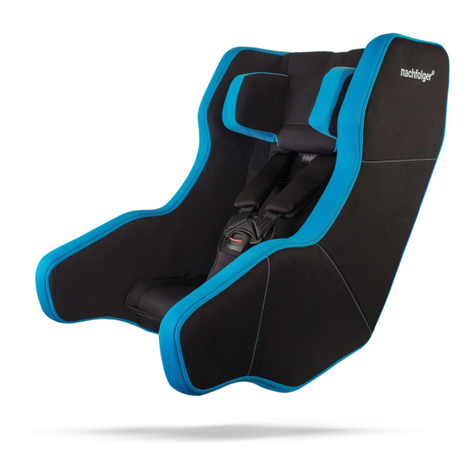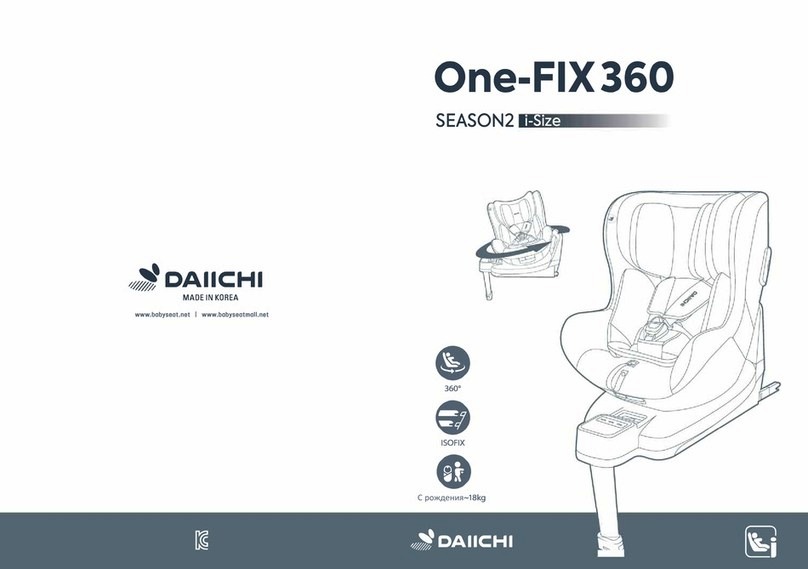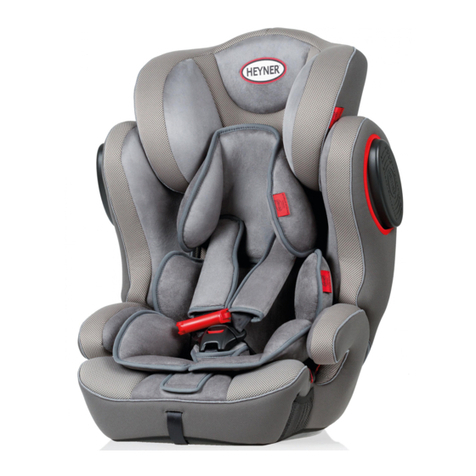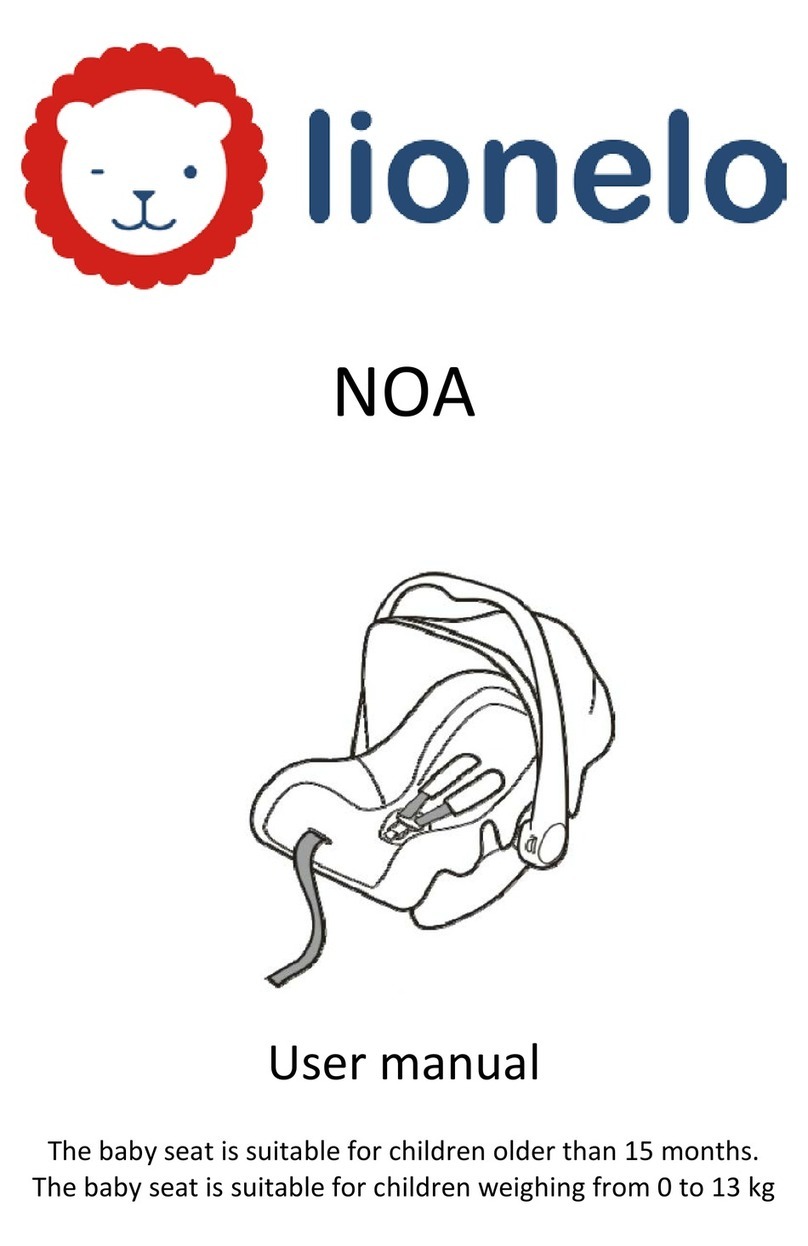Spar ECE R44/04 User manual

CHILD CAR SEAT FOR GROUPS 1+2+3
INSTRUCTION MANUAL
GB
ECE R44/04
Groups 1+2+3

2
Dear parents
• Thank you very much for purchasing our product.
• The credible design in accordance with somatology and
excellent functionality aords the safest and most comfortable
journey when your child is in this seat.
• In order to maximize the safety and functionality of this
child seat, please adjust the child restraint till it is suitable
for your child’s stature before using our product and then
install it carefully.
• Research shows that a high number of car safety seats
are incorrectly installed. Therefore we would ask you to
please take the time to read through this instruction
manual carefully. Our product oers maximum safety only
when it is used in accordance with the instructions.
• Continuous research by our development team, user tests
and consumer reviews ensure that we are kept fully up to
date in the field of child safety in cars. Therefore, if you
have any questions concerning the use of the our product,
please do not hesitate to contact us.
• You can see our contact information in the service card.
• This child seats has been designed for the European
market and conforms to the car seat regulations currently
in force: European Union ECE R44; PLEASE NOTE that this
seat doesn’t meet the USA regulation.

Warning
GB
3
Important
• Read this instruction manual carefully.
• The correct fitting of the ISOFIX and Top Tether anchoring
systems or 3-point belt is of vital importance for the safety
of your child.
• For any future use of the seat, it is important that you
keep the instruction manual carefully. There is a pocket on
the side of the base where the instruction manual can be
stored with the child restraint for future reference and use.
• Never leave your child unattended in the car.
• Do not use a child safety seat if the vehicle seat is
equipped with a front airbags - this can be dangerous. This
does not apply to so-called side airbags.
• Before using our product, please read the instruction
manual carefully. This product is a safety product and is
only safe when used in accordance with the instruction
manual.
• The product must only be used on a forward facing seat
that is fitted with the ISOFIX and Top Tether anchoring
systems or 3-point belt which is approved according to ECE
R16 or an equivalent standard. The product may be used on
either the front or the back seat. However, we recommend
that it is fitted on the back seat.
• The product has been approved according to the strictest
European safety standards (ECE R44/04) and is suitable for
Group I (9-18kg) with the ISOFIX and Top Tether anchoring
systems, Group II (15-25kg) and Group III (22-36kg) with
3-point belt or ISOFIX attachment with 3-point belt.

4
•After an accident the seat may become unsafe due to
damage that may not be immediately noticeable. It should
therefore be replaced. The safety of the seat can only be
guaranteed by the manufacturer if it issued by the original
owner.
•We strongly advise not to use a second-hand product, because
it is not possible to know exactly what has previously happened
to it or if it holds any damages that would aect the safety
performance.
•The harness pads are important for the safety of your child,
therefore use them at all times.
•Ensure that all luggage and objects likely to cause injury in
the event of an accident are properly secured or stored away.
•It is recommended that the car seat should not be used more
than 5 years from the date of manufacture. The properties of
the product may deteriorate due to, for example, ageing of the
plastic and this may not be visible.
•The moving parts of the car seat should not be lubricated in
any way.
•The child car seat must not be used without the cover.
Please use an original cover, as the cover contributes to the
safety of the seat.
•The seat must be secured with a seat belt or ISOFIX and
Top tether, even when it not on use. An unsecured seat may
injure other passengers in the car in event of a sudden stop.
•The rigid items and plastic parts of a child restraint should
be correctly installed or clipped away during everyday use of
the vehicle to avoid becoming trapped by a movable seat or
in a door of the vehicle.
•Ensure that the seat is not damaged by heavy luggage,
adjustable seats or slamming the car door etc.

5
• No alterations may be made to the product as this could
aect part of, or the overall safety of the seat.
• In hot weather the plastic and metal parts of the product
may become hot. You should attempt to cover the seat when
the car is parked under direct sunlight or in hot weather.
• In order to prevent damage to the cover, do not remove the
product’s logo.
• Remember to use the seat even in the shortest of journeys,
as this is when most accidents tend to occur.
• Before purchase, please check that the seat fits properly in
your car.
• Take a short break during long journeys so that your child
has some time for relaxation.
• Set a good example yourself and always wear your seat belt.
• Inform your child that he/she should never play with the
harness buckle.
Questions
Contact your supplier or importer if you wish to make a
warranty claim or have any other questions.
Your car seat can be fixed safely on almost seats of the cars.
However, on some seats the belts are fixed so that proper
installation is not possible, in that case, try another seat.
GB

6
Headrest
Headrest Adjusting handle
(only for Group 1)
Shoulder Pad
Harness Strap
Buckle Pad
Harness Adjusting
strap
Harness Slots
Harness Buckle
Adjusting Device
Reclining
handle
Know your car child seat

7
Shoulder Belt Guide
Headrest Adjusting
(only for Group 2+3)
Top Tether
Release Button
Top Tether
Strap
Top Tether
Hook
Locking arm
Isofix
Release Button
Know your car child seat GB

8
Suitability
...as a child safety seat installed in a vehicle.
Child Safety Seat
Tested and certified
according to ECE* R 44/04
Group
1+2+3 9-36kg
Body Weight
SK700
1. Certification
The child safety seat has been designed, tested and certified
according to the requirements of the European Standard for
Child Safety Equipment (ECE R 44/04).
The seal of approval E (in a circle) and the approval number
are located on the approval label (sticker on the child safety
seat).
This approval will be invalidated if you make any modifications
to the child safety seat. Only the manufacturer is permitted to
make modifications to the child safety seat.

Use in the vehicle
9
2. Use in the vehicle
DO NOT use with 2-point belt.
Please install with the 3-point
belt.
You can use your child car seat as follows:
Please observe the regulations applicable to your
particular country.
The safety belt must be approved to ECE R 16 or a
comparable standard.
Do not use with a 2-point belt.
The seat can only be used if the vehicle seat is
equipped with a 3-point belt.
Warning
GB

Use in the vehicle
10
In the direction of travel Yes
Yes
Yes
Yes
Yes
Yes
No
No
Against the direction of travel
With 2-point belt
With 3-point belt
With the ISOFIX and Top Tether anchoring systems
On front passenger seat
On outer rear seat
Can be used if the vehicle seat is equipped with a 3-point belt
(Please observe the regulations applicable to your particular country).
On centre rear seat
The use of a 2-point belt substantially increases the risk of
injury to your child in the event of an accident.
The safety belt must be approved to ECE R 16 or a comparable
standard (see test label on belt with an "E" or "e" in a circle).
If there is a front airbag: Slide the passenger seat a long way
back and refer to any instructions in vehicle owner’s manual.
Do not use on passenger seats with a front airbag! The
front passenger seat may be used with or without ISOFIX,
with the same notes as currently given for the ISOFIX
(slide the seat back and refer to vehicle instructions).

Securing your baby
11
• Always secure your child in the car seat using the harness.
• Never leave your child unattended in the car seat when
placing it on elevated surfaces (e.g. a table, nappy changing
unit, etc.).
• Never allow the strap end to become caught in moving
parts (e.g. automatic doors, escalators, etc.).
• Caution! The plastic parts of the car seat heat up in the sun
- overexposure to the sun may cause your child to be burnt
from making contact with these heated plastic parts. Protect
your child and the car seat against intensive solar radiation
(e.g. by putting a light cloth over the seat during hot or warm
weather).
• Take your child out of the car seat as often as possible
during journeys to relieve its spine. We recommend frequent
breaks during long journeys. Even outside of the car, please
avoid leaving your child in the car seat for too long.
For the protection of your baby.
GB

Securing your baby
12
3.1 How to adjust the belts, headrest and seat positions
Important
The correct belt height of the shoulder belts are attained
when the belt disappears into the shell slightly above the
shoulder of the child.
Make sure that the shoulder belts fit properly over the
shoulders of the child.
Loosen the harness straps by pressing the release button
and pulling the harness straps as far as you can.
Note! Do not pull the shoulder pads.
The headrest can be set at five dierent
heights in group 1 mode with the
shoulder belts axle in place. There are
seven additional positions in Group 2 & 3
mode once the shoulder belts axle and
harness straps have been removed.
Press the button on the headrest handle
on the top of the seat. It is important to
make sure the headrest fits properly to
the child’s head.
The recline angles of the car seat can be
adjusted by reclining handle. (Only For
Group 1).
3.1-1 Adjusting the belts
3.1-2 Twelve heights of the headrest
3.1-3 Stepless adjustment device

13
Securing your baby
3.2 Securing your baby using the harness
Loosen the harness straps by pressing the
release button and pulling the harness
straps as far as you can.
Note! Do not pull the shoulder pads.
Open the harness buckle,
then place the harness
straps to the sides of the
car seat. Put the child into
the car seat.
The correct belt height of the shoulder
pads is attained when the strap
disappears into the shell slightly above
the shoulders of the child. Make sure that
the harness straps fit properly over the
shoulders of the child.
Slide the buckle tongues together and
insert them into the buckle - correct
connection will create an audible “click”
sound.
Tighten the straps by the harness
adjustment strap and make sure the
tightness is comfortable for your child.
Do not twist or interchange the harness straps.
Caution
GB

14
Securing your baby
3.3 Tightening the harness
3.4 Checklist to ensure that your child is buckled up
correctly
Pull the ends of the straps
straight towards you, not
upwards or downwards.
Please pay attention to the strap
end whilst traveling - it should
always be attached to the cover
(especially outside the car).
For the safety of your child, please check that...
The harness straps of the car seat are
a comfortable but firm fit around your
child.
The harness straps are adjusted
correctly.
The harness straps are not twisted.
The buckle tongues are engaged in the
harness buckle.
Caution

15
Installation in the vehicle
4. Installation in the vehicle
To protect your vehicle
Please do not leave your child unattended in the
vehicle, even in the child safety seat .
For the protection of all vehicle occupants.
In the case of an emergency stop or an accident, unsecured
persons or objects may cause injury to other vehicle
occupants. Please always check that...
The backrests of the vehicle seats are locked in (i.e.that a
foldable rear seat bench latch is engaged).
All heavy or sharp-edged objects in the vehicle (e.g. on the
parcel shelf) are secured.
All persons in the vehicle have their seat belts fastened
correctly.
The child safety seat is always secured when it is in the
vehicle, even if no child is being transported.
Some vehicle seat covers made of sensitive materials (e.g.
velour, leather, etc.) may develop wear marks when child
seats are used.
This can be avoided by placing a blanket or towel under the
child seat.
GB

16
ISOFIX and Top tether
4.1 Installation of Group 1 for children whose weight is
between 9-18kg with ISOFIX and Top tether.
First check if there are 2 ISOFIX anchorages in the
perpendicular intersection of the vehicle seat back and
seat cushion, as well as the user-ready tether anchorage
behind the vehicle seat.
Tips: The user-ready tether anchorage in cars is usually
permanently installed on the inner rear luggage shelf or
on the vehicle floor. For further details you should read
your vehicle guidelines or contact the vehicle manufacturer.
Press the ISOFIX release button and
push the ISOFIX connectors forward as
far as possible.
Push the ISOFIX
connectors directly
into the anchorages
until you hear an
audible “click” sound.
Grasp the seat body to check the seat if
it is fastened tightly or if it shakes. If the
seat shakes and the ISOFIX connectors
are pulled out, please repeat the above
steps and reinstall it again.

ISOFIX and Top tether
17
4.1 Installation of Group 1 for the children whose
weight between 9-18kg with ISOFIX and Top tether.
Pull out the top tether and
press the tether strap
release button to extend
the strap until it is long
enough in order to hook
on to the user-ready
tether anchorage behind.
Hook the tether strap
hook onto the
user-ready anchorages.
There maybe are 3
anchorages for the hook
to connect to, please find
the one best suited to
connect to.
Pull the tether strap on the other end
back to tighten the top tether.
If the top tether is tightened
favorably and correctly, a green
mark will turn up on the other end of
the strap release button, please
check for it.
Caution
GB

Group 2+3 Car belt installation
18
4.2 Installation of Group 2+3 for children whose weight
between 15-36kg.
Before the installation, please put away
the harness system of the child car seat.
Note: The Child insert, Harness strap,
Harness buckle, Buckle pads & Shoulder
pads should be stored away safely for
future use ( see 5.1 Removing the 5-point
harness system and cover).
Do not to use any load bearing contact points other than
those described in the instructions and marked in the
child restraint.
The belt must be routed as shown in the instructions.
Adjust the height of the headrest to suit
your child.
Put the shoulder belt through the
shoulder belt guide under the headrest.
Place your child into the car seat and
pass the belts through the bottom of the
armrest. Fasten the car belt with an
audible “click” sound.
Make sure the Lap belt is stretched as
low as possible over the child’s hips,
within the Belt guides, and fastened into
the buckle. The Shoulder belt must cross
midway between child's shoulder and
neck.
warning

Group 2+3 ISOFIX attachment + car belt installation
19
4.3 Installation of Group 2+3 for children whose weight
between 15-36kg.
Before the installation, please put away the
Harness system of child car seat.
Note: The child insert, Harness strap, Harness
buckle, Buckle pads & Shoulder pads should be
stored away safely for future use (see 5.1
Removing the 5-point harness system and
cover).
Adjust the height of the headrest to suit
your child.
Push the ISOFIX connectors directly into
the anchorages until you hear an audible
“click” sound.
Place your child into the
car seat and pass the
belts through the bottom
of the armrest. Fasten the
car belt with an audible
“click” sound.
Make sure the Lap belt is stretched as low
as possible over the child’s hips, within the
Belt guides and fastened into the buckle.
The Shoulder Belt must cross midway
between child's shoulder and neck.
Do not to use any load bearing contact points other than
those described in the instructions and marked on the
child restraint.
The belt must be routed as shown in the instructions.
warning
GB

20
5.1 Hiding the 5-point harness
system and cover.
Pull the handle to open the backplane.
Press the adjustment device and pull
the harness strap out of the strap yoke
to unlock it.
Pull the shoulder
strap axle out from
the gap of the shell.
Then untie the
shoulder strap and
pull it out from the
harness slots.
Roll the belt together,
then hide it in the
slot in bottom of
the backrest.
After the above steps,
pull the cover around
the adjusting device
down and take it out
from the edge of the
adjusting device. Then
remove the 5-point
harness system, headrest cover and shell
cover. At the same time also hide the
buckle in the slot as shown in the picture.
Care instructions
Table of contents
Languages:
Other Spar Car Seat manuals
